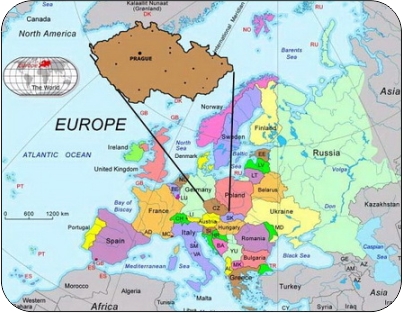The Czech Republic
 The Czech Republic is a small country in the heart of Europe, which has an appeal for visitors.Thanks to its location at the crossroads of various cultures, the Czech Republic has countless cultural and historical points of interest.
The Czech Republic is a small country in the heart of Europe, which has an appeal for visitors.Thanks to its location at the crossroads of various cultures, the Czech Republic has countless cultural and historical points of interest.
The Czech Republic and the Slovak Republik were founded on 1.1.1993 after the division of Czechoslovakia.
The country is situated in the middle of Europe and is the hub of several major areas including Western and Eastern Europe, the Balkans and Scandinavia. The Czech Republic also shares the longest border with the strongest economical power in Europe, the Federal Republic of Germany. The physical land area put into a category of smaller countries in size order falls into the 21st place, following Hungary, Portugal and Austria, ahead of Ireland, Lithuania and Latvia. The number of inhabitants places the total population of the Czech Republic 14th in Europe after Hungary, Portugal and Belorussia, ahead of Greece and Belgium.
Aside from the Czechs: Moravians, Silesians, Slovaks, Germans, Polish, Roms and other nationalities also inhabit the culturally diverse country.
Bohemia, the official name of the region, is derived from Celtic tribe Boii; who were the first inhabitants of the place we now call Bohemia. There is also definitive evidence that the area was once occupied by the Slavs in the 6th century A.D. The long history of Bohemia and Moravia can be traced through Samo´s empire, the Great Moravian empire, the reign of the Premysl´s, the Luxemburg and Habsburg dynasties, the Catholic expansion leading to the Thirty year war, the decline of the Austro-Hungarian empire up to birth of the Czechoslovakia Republic led by the first president, Tomas Garigue Masaryk. After surviving German occupation and forty years of communist rule, the Czech Republic is now experiencing yet another stage of transition, this time to a completely restructured free-market.
Over the centuries a whole number of Czech men and women have become famous throughout the world - Holy Roman Emperor Charles IV, reformer John Huss (Jan Hus), the "Teacher of Nations" Comenius (Jan Amos Komensky), composers Bedrich Smetana, Antonin Dvorak and Leos Janacek, writers Jaroslav Hasek, Karel Capek and Franz Kafka, Nobel Prize winners Jaroslav Heyrovsky and Jaroslav Seifert, opera stars Emmy Destinn and Jarmila Novotna etc.
The Czech Republic is a country of great historical and cultural importance, a country where historic monuments and entire towns have been included on the World Heritage List. Of course, when discussing tourism in the Czech Republic, one can not overlook the overwhelmingly popular tourist destination of Prague. The city is generaly considered to be one of the most beautiful world capitals with an exquisitely preserved historical center.
Many other towns and historic monuments in the Czech Republic are well-preserved and are noted in the UNESCO register as world cultural landmarks: Kutna Hora, Telc, Cesky Krumlov, the Church of St.John of Nepomuk on Zelena Hora, the Lednicko-Valticko area, monuments in Kromeriz, Holasovice village, the castle and historical center at Litomysl and some rare monuments and areas in Brno, Olomouc and Trebic. Some of the towns are also known as glowing assets of the Czech Republic due to the existence of curative mineral spring spas there. Spas like Karlovy Vary (Karlsbad) and Marianske Lazne (Marienbad) acquired their international eminence many years ago. Jachymov, another town in the countryside, is well known for its rare radioactive springs. Terezin is also often explored by tourists, but unfortunately its history is stained by war. Terezin was a fort town from the end of the 18th century which, during the war, was transformed into a Jewish ghetto by the Nazis.
For more information about Czech Republic please visit the official website.
© 2010 Konferenční centrum Ústavu molekulární genetiky AV ČR
Powered and created by CZECH-IN s.r.o. | XHTML 1.0 Strict | CSS 2.1




